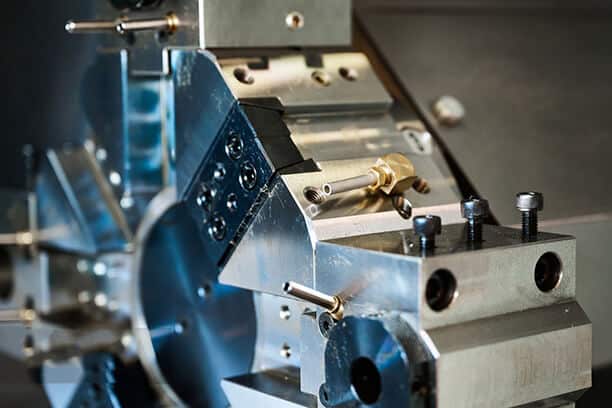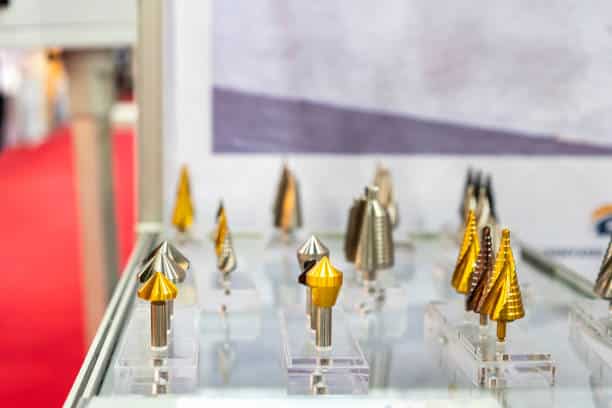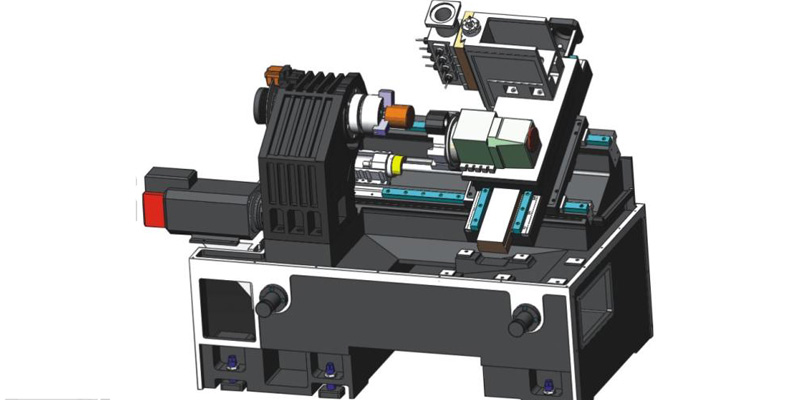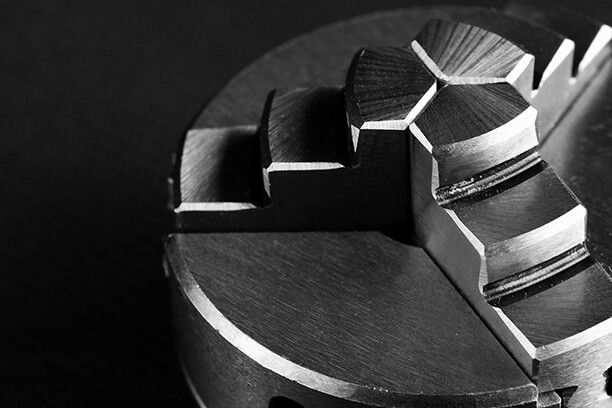A lathe machine is a versatile tool used for various operations such as turning, threading, drilling, boring, knurling, and more. However, each operation requires different tools, and changing these tools for each operation increases the time it takes to complete the process.
To address different needs, increase productivity, and simplify the procedure, a special type of metalworking lathe called a turret lathe was created. But what makes turret lathes distinct from other types of lathes?
This article will cover the details of turret lathes. It will discuss what they are, how they work, structures, and their different types. Moreover, it will explore the distinct features of a turret lathe compared to an engine lathe and a capstan lathe.
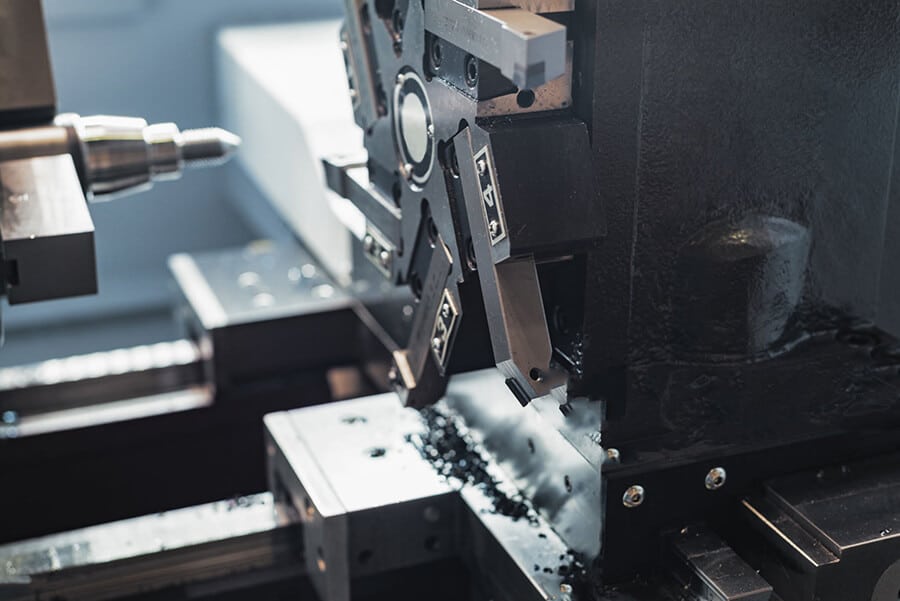
What is a Turret Lathe?
A turret lathe is an updated version of the traditional metal lathe. It features a turret – a convenient tool holder that can be indexed. Typically, a turret holds six cutting tools that can be used to perform multiple cutting operations in a single session on a single machine. This eliminates the need for the operator to perform setup tasks or manually control the toolpath.
The early form of the turret is a flattened cylindrical block that is mounted on the cross slide of the lathe. It can rotate around a vertical axis, and it has tool holders that project outwards in all directions. This configuration resembles a swiveling gun turret, which is how the turret lathe got its name.
In contrast, traditional lathes only accommodate a single cutting tool. As a result, it takes several minutes to manually replace cutting tools as needed. However, the rotating turret in a turret lathe can automatically switch to the appropriate cutter to perform various machining operations without halting the process. This significantly improves efficiency and productivity.
How Does a Turret Lathe Work?
In preparation for cutting, the workpiece is secured in the chuck of the lathe. The cutting tools are then placed into the designated holes of the hexagonal turret. Rotating the spindle causes the chucks to also rotate, resulting in the workpiece attached to the chuck spinning. By moving the saddle, the hexagonal turret head moves closer to the rotating workpiece. The hexagonal head can be further rotated to align the desired tool with the workpiece.
Once the desired tool aligns with the workpiece, it comes into contact with it to perform the necessary operation. After completing one operation using a specific tool, the hexagonal turret head rotates to advance the next tool into position, allowing for different operations to be performed sequentially.
In a manual turret lathe, the operator uses the required tools directly through the turret. Conversely, in an automatic turret lathe, the turret head returns to its initial position after each operation, and the tool automatically indexes or repositions itself.
Main Parts of a Turret Lathe
The important parts of a turret lathe machine are:
- Headstock
- Turret
- Tool Post
- Cross Slide
- Driving Clutch
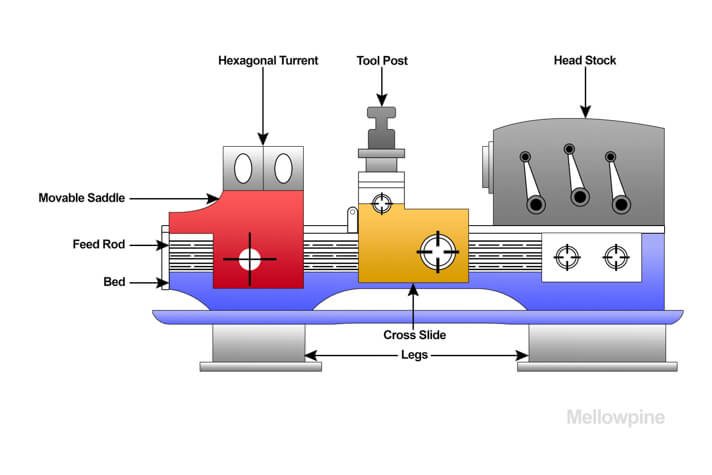
Headstock
The headstock of a turret lathe is the component that houses all the driving mechanisms. It serves as the location for various controls, such as start, stop, and speed control. Depending on the type of drive system, headstocks can be categorized into two types: electric headstock and geared headstock.
In an electric headstock, the spindle speed is adjusted by controlling the speed of the electric motor. This type of headstock offers precise speed control, though it might sacrifice some torque. Electric headstocks are typically used when machining smaller workpieces.
In contrast, geared headstocks utilize specialized gear configurations to alter the spindle speed. By employing gears, the spindle speed can be reduced while increasing its torque. This makes geared headstocks well-suited for machining larger workpieces with greater diameters. Such headstocks are commonly found in larger lathes used for cutting deeper into hard materials.
Turret
The turret in a lathe machine is a tool holder with a hexagonal shape that can rotate vertically. It is mounted on a saddle and has four tapped holes on each face to secure attachments. The turret has the capacity to hold up to six tools, and its rotation allows easy access to the required tools for different machining operations such as turning, boring, and knurling.
In addition, the saddle is capable of horizontal movement, which allows the cutting tool to advance towards the workpiece. For instance, when working on a hollow aluminum cylinder, two different cutting tools are needed for the turning and tapping operations to complete the machining process.
In this case, the turning operation is performed by a turning tool. After that, the turret can be rotated to approach the tapping tool, enabling the tapping operation to be carried out. The turret is placed on a movable bearing, allowing the operator to turn it to change the tool position once the clamps are released.
Tool Post
In a turret lathe, the cutting tools are mounted on a tool post. The tool post has the ability to move in both the X and Y directions, as well as across the bed, using the carriage. These movements can be controlled manually using a handwheel or can be automated for convenience.
Cross Slide
The cross slide, also known as the carriage, is located between the tool post and the saddle of the lathe machine. It has the ability to move sideways, perpendicular to the movement of the saddle.
Driving Clutch
The driving clutch of a turret lathe functions similarly to the clutch in an automobile. It’s responsible for connecting and disconnecting the prime mover (which can be a motor or a gear-coupled shaft) with the spindle. In the default state, the prime-mover and the spindle are disconnected, and you can utilize the driving clutch to engage them before starting the machining process.
Types of Turret Lathe
There are five different types of turret lathes based on their operation, orientation, and the number of turrets they possess.
1. Horizontal Turret Lathe (Manual)
The horizontal turret lathe is the oldest and most widely used type of turret lathe. As the name implies, it has a turret positioned horizontally. The axis of the turret is aligned with the axis of the workpiece.
2. Vertical Turret Lathe
A vertical turret lathe is a type of lathe where the axis of the turret head is positioned perpendicular to the machine’s base. The turret head can move vertically and horizontally along the guideways. In addition to the vertically oriented turret, the lathe features two square tool posts on the sides. Each tool post has the capacity to hold 4 tools.
The tool posts can also be moved in the X and Y directions, allowing for machining operations to be performed on the workpiece. As a result, a vertical turret lathe has a total capacity of accommodating 14 different tools for working on the material. This specific type of turret lathe is well-suited for handling large and heavy workpieces.
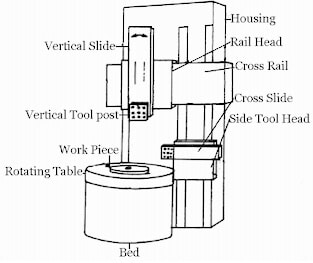
3. Twin Turret Lathe
A twin-turret lathe is a lathe machine that features two automated turrets, each capable of performing machining operations on the workpiece simultaneously. This results in a significant reduction in the overall cycle time compared to a single turret lathe when carrying out similar machining operations.
In a twin-turret lathe, one turret leads the other. This sequential operation between the two turrets enables the machine to perform both roughing and finishing operations in a single pass. In addition, the design allows for loading and unloading of parts from one spindle without interfering with the operation of the other. Some twin-turret lathes can even run two separate programs on each of their spindles, further enhancing their versatility.
While the setup process for a twin-turret lathe takes longer compared to a single-turret lathe, these machines are particularly well-suited for batch production which involves producing a high volume of similar products in a single manufacturing run. In such cases, the increased productivity and efficiency offered by twin-turret lathes make them an ideal choice.
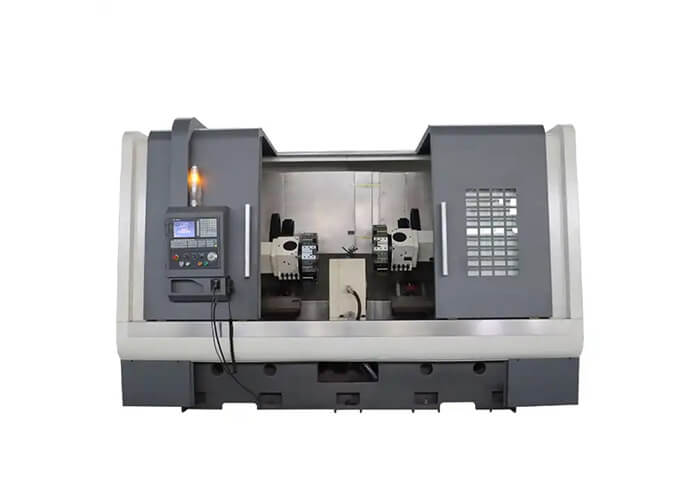
4. Automatic Turret Lathe
An automatic turret lathe is an upgraded version of the manual turret lathe. With this type of turret, the sliding and indexing of the turret can be automated using a camshaft. This automation improves productivity by reducing the time required for machining operations. Consequently, there is less dependency on a skilled operator to manually control the machine.
The automation of the process also improves repeatability, making automatic turret lathes well-suited for mass production. However, it’s important to note that the automation of sliding and indexing with a camshaft is more suitable for simple geometric shapes. It may not be as effective for producing complex geometries.
5. CNC Turret Lathe
CNC turret lathes utilize computer-generated G-code instructions to control the spindle speed, feed rate, and movement of the turret. The controller interprets these G-codes and directs the CNC turret lathe to carry out the desired machining process.
These machines are equipped with automatic tool changing capabilities on the turret, without the need for manual intervention during the machining operation. With computer-controlled tool movement, CNC turret lathes are well-suited for machining intricate shapes with exceptional accuracy.
Turret Lathe vs Engine Lathe – Difference Between Turret Lathe and Engine Lathe
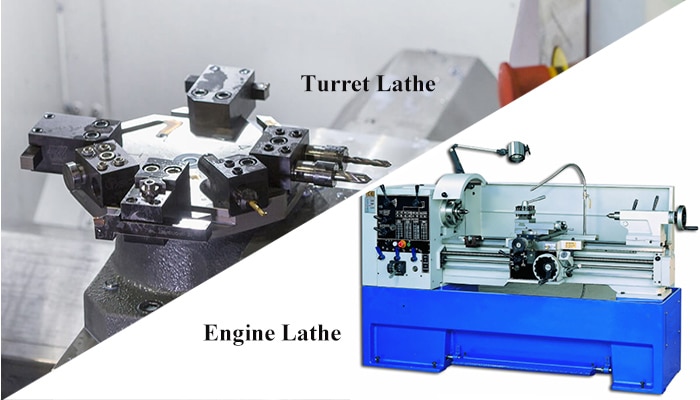
The main difference between a turret lathe and an engine lathe lies in their capacity to hold cutting tools. Typically, an engine lathe is equipped with a tool post that can accommodate a maximum of 4 cutting tools. On the other hand, a turret lathe has a turret that can hold up to six cutting tools simultaneously.
Turret lathes require a longer setup time, but they offer a quicker machining rate, making them well-suited for mass production. Conversely, engine lathes require less setup time, but slower machining speed in return.
Turret lathes offer enhanced flexibility in adjusting the spindle speed, enabling them to effectively carry out a wide range of machining operations on different types of materials.
The table below summarizes the distinct characteristics and features of the turret lathe and engine lathe.
| Characteristics | Turret Lathe | Engine Lathe |
| Operation | Semi-automatic | Manually operated |
| Rotation direction | Either the clockwise or anti-clockwise directions | Only the anti-clockwise direction |
| Setting time | Long | Quick |
| Spindle speed | Wide range | Few amounts |
| Type of taper | Only short length taper | Any type of taper turning |
| Thread cutting | Short threads cut by a chaser | Longer threads cut by a lead screw |
| Tool changing | Fast | Only one tool of limited size |
| Machining rate | Ideal for mass production | Not suitable for mass production |
| Speed | Faster | Slower |
| Size | Relatively small | Large |
| Number of tools contained | Up to six | Only one at a time |
| Tool wear | Less | Frequent |
| Operating skill | Low | High |
Turret Lathe vs Capstan Lathe – Difference Between Turret Lathe and Capstan Lathe
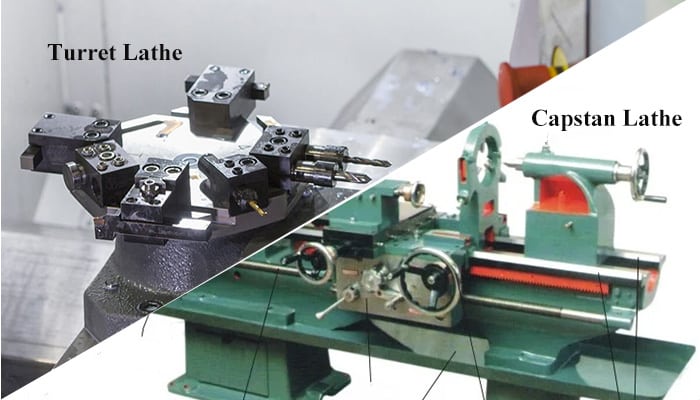
The capstan lathe machine was the initial innovation to utilize a hexagonal turret head for tool mounting. It was introduced as an upgrading version to the center and engine lathe machines.
Due to their non-rigid construction and lightweight, capstan lathes are not suitable for carrying out heavy cuts on a workpiece. In contrast, turret lathes, being heavier and more stable, perform heavy cuts with relative ease.
Capstan lathes are faster than turret lathes due to their high capacity for handling smaller workpieces. On the other hand, turret lathes are larger and can accommodate workpieces that are nearly twice the size of what capstan lathes can handle.
In capstan lathes, the ram moves along the saddle to provide feed to the tool. This restricted motion reduces the maximum length of the stock that can be machined on a capstan lathe. Conversely, turret lathes have a saddle that can slide along the guideways, offering a larger range of motion which allows turret lathes to handle longer workpieces and perform machining operations on them.
In certain turret lathes, the turret head can be moved laterally in relation to the bed. However, capstan lathes do not provide the capability for lateral turret movement.
The indexing mechanisms in these two types of lathes differ significantly. In capstan lathes, the tool indexing is achieved by rotating the handwheel of the ram in the opposite direction. In contrast, turret lathes require manual rotation of the turret itself, after releasing all the clamps, in order to index the tools.
The capstan lathe and turret lathe are quite similar, especially when it comes to their suitability for mass production. However, they do have some distinct differences, which are outlined in the table below.
| Characteristics | Turret Lathe | Capstan Lathe |
| Machine orientation | Horizontal or vertical | Horizontal |
| Turret shape | Hexagonal | Hexagonal, Square, or circular |
| Turret head mounted on | On the saddle | On the ram |
| Turret head movement | Moved crosswise | Can’t be moved crosswise |
| Tool head | A hexagonal tool head | A simple tool head |
| Feed motion | Saddle is moved | Ram is moved |
| Saddle motion | Moved along with the turret head | Fixed |
| Indexing | Manual indexing | Automatic indexing |
| Workholding | A jaw chuck holds the workpiece in place | A collect holds the workpiece |
| Workpiece size | Up to 120mm in diameter | Up to 60mm in diameter |
| Weight of machine | Heavyweight | Lightweight |
| Tool feeding rate | Relatively slower | Relatively faster |
| Operation speed | The heavy cut makes it generally slower in operation | Faster in operations |
| Lengthwise movement | The lengthwise movement of the turret is more | The lengthwise movement of the turret is less |
FAQs
Conclusion
A turret lathe machine is a specific type of metalworking lathe that is widely used for the efficient production of duplicate parts. Its hexagonal turret acts as an indexable tool holder to accommodate and interchange up to six tools simultaneously. This feature enables the turret lathe to perform a wide range of operations quickly.
Here, we have explored the turret lathe in detail including its functions, working principle, main components, and different types, and compared it to other types of lathes: the engine lathe and the capstan lathe.
Custom Precision Machining Services at Runsom Precision
If you need a reliable manufacturer offering a wide range of machining services such as milling, turning, boring, drilling, and threading, Runsom Precision is the perfect solution. We pride ourselves on being a comprehensive machine shop that can satisfy different machining requirements. Our services cover projects of any size or complexity, catering to precision components needed for both small and large-scale production. With our expertise and capabilities, we are fully equipped to fulfill your needs. Request an instant quote to start your projects today!
Other Articles You May Be Interested in:

